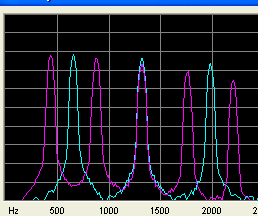Just intonation scale
If you put your finger on half the string you get the interval of an octave
If you put the finger on 1/3 of the string (So there is 2/3 left for making sound )you get a pure fifth
If you put the finger on 1/4 of the string (So the sounding part is 3/4 ) you get a fourth
If you put the finger on 1/5 of the string (So the sounding part is 4/5 ) you get a major third
If you put the finger on 1/6 of the string (So the sounding part is 5/6 tillbage) you get a minor third
I believe that the reason these intervals sound good because the overtones are meeting. (see the picture)
In modern western music the most basic chord the major triad consists of a major third, a fifth and an octave. 1/5, 1/3 og 1/2.
If you take 1/6, 1/3 og 1/2 of the string you get a minor chord.
Now if you make a chord from the root, from the fourth and from the fifth, you get a a scale with 7 notes (or 8 if you include the octave)
The frequencies are calculated as one divided by the string length. You get the frequency of fthe interval by taking one divided by the string length (the inverse relation)
(You get the second tone frequency by multiply the two fifth frequencies 3/2 * 3/2 = 9/4 You have to multiply the frequency with two to go an octave down
| Interval name | Prim | Second | Major Third | Fourth | Fifth | Major Sixth | Major seventh (lead tone) | Octave |
| Scale tone | 1 | 2 | 3 | 4 | 5 | 6 | 7 | 8 |
| Get it from | root | Fifth + fifth | Major third | fourth | Fifth | major third + fourth | major third +fifth | fifth + fourth |
| Fingerns position | whole string | 1/9 | 1/5 | 1/4 | 1/3 | 2/5 | 7/15 | 1/2 |
| String left | 1 | 8/9 | 4/5 | 3/4 | 2/3 | 3/5 | 8/15 | 1/2 |
| Frequency ratio | 1 | 9/8 | 5/4 | 4/3 | 3/2 | 5/3 | 15/8 | 1/2 |
|
Frequency to next note |
9/8 | 10/9 | 16/15 | 9/8 | 10/9 | 9/8 | 16/15 | - |
| Frequency (A-major) |
440 | 495 | 550 | 586.666 | 660 | 733.33 | 825 | 880 |
Move the mouse across the frequency and you can here the note (MS IE browsers only)
The didymic komma
Tune you violin, then put your finger at a B on the A-string and get a clean quarter witht he E-string, Now make a clean sixth with the D string. You will have to move your finger 1/6 th of an inch!!)
The calculation is (9/4)/(4/3) * 3/5 or (9*3*3)/(4*4*5)
In other words the frequency is 81/80 higher. or in string length 80/81 A violin string is 33 cm. The finger is moving 4 millimeter (1/6 of an inch) corresponing to about 1/8 note. .
.
